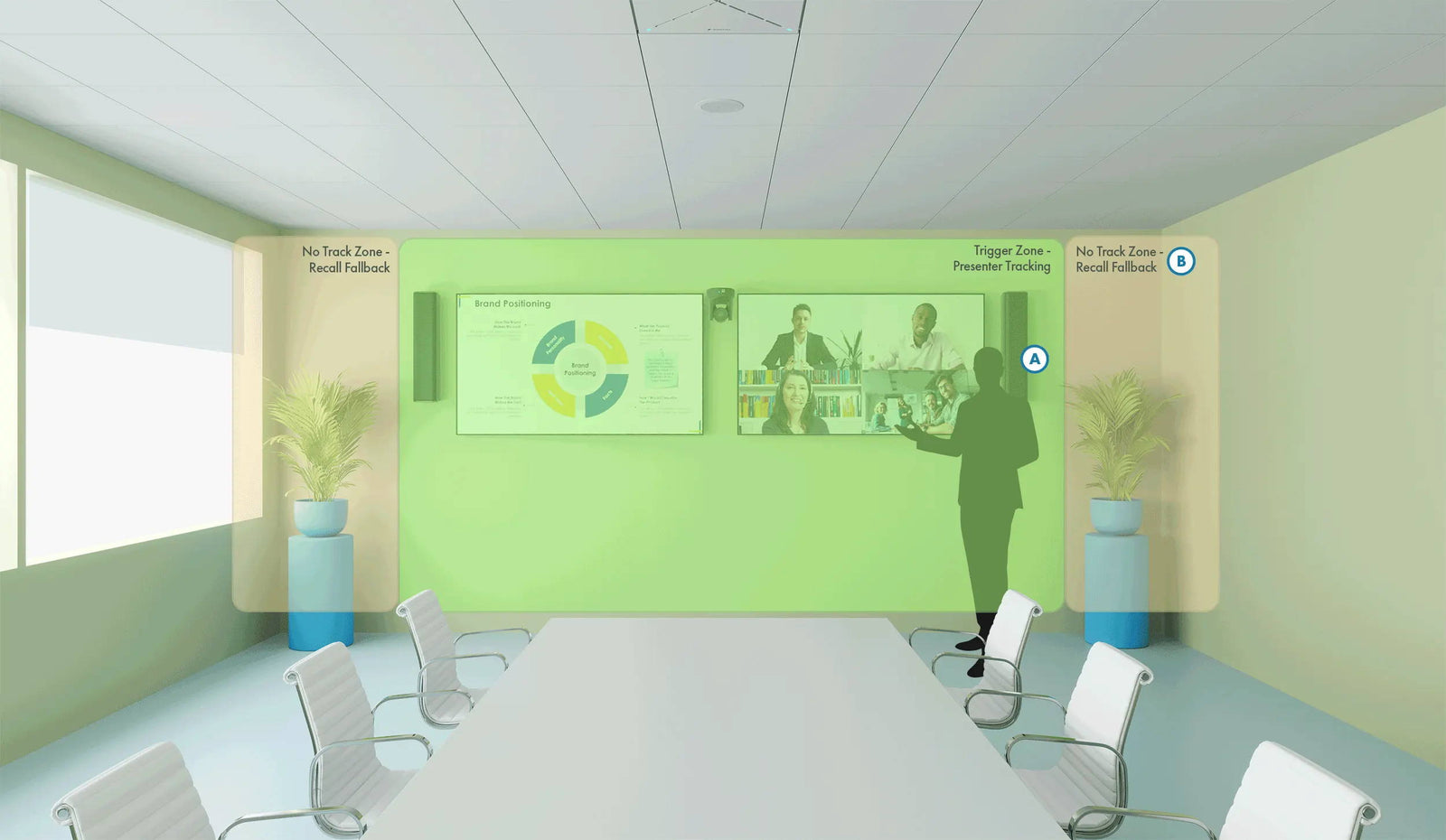Complete QSC AV Automation
Seervision develops multi-camera automation software that seamlessly integrates into your existing AV/IT ecosystem. Our IP-based solution allows you to fully automate PTZ camera control for higher education and hybrid meeting spaces.
Intelligent Video for Presentation Spaces
The Seervision solution is an AI accelerator that leverages computer vision-based scene analysis, and adaptive full-body tracking that automatically follows and frames a presenter for a more natural experience. The solution uses video from connected QSC Q-SYS network cameras and is highly configurable, allowing users to set alternate framing modes, fallback shots, and trigger zones which can be used to trigger alternate camera shots or additional room automation when paired with Q-SYS Control capabilities.
Smart and reliable auto-tracking
Make the Switch Automatically
Enhance meeting experiences by combining Seervision functionality with QSC Q-SYS Automatic Camera Preset Recall (ACPR) functionality. ACPR uses audio data from in-room microphones to determine where a talker is in a room to automatically switch between user-defined camera presets, resulting in better visibility of participants on the near-end, and a more natural viewing experience for audiences on the far-end, keeping all engaged.
Video-driven Automation
Leverage both the Q-SYS Control engine and Seervision computer vision analysis to automate other in-room devices and events, creating a holistic and autonomous experience. Imagine a presenter triggering lighting changes, toggling power on a display, or adjusting a voice-lift audio setting, simply by walking to a specific section of the room. The possibilities are endless for a uniquely tailored, full-room Q-SYS experience that will continue evolving its AI-driven capabilities well into the future.
Autonomous lecture capturing
Leverage both the QSC Q-SYS Control engine and Seervision computer vision analysis to automate other in-room devices and events, creating a holistic and autonomous experience. Imagine a presenter triggering lighting changes, toggling power on a display, or adjusting a voice-lift audio setting, simply by walking to a specific section of the room. The possibilities are endless for a uniquely tailored, full-room Q-SYS experience that will continue evolving its AI-driven capabilities well into the future.
QSC Use Case Examples
QSC Q-SYS and Seervision offer a scalable, intelligent video solution that addresses the varying presentation and collaboration needs found in meeting rooms, lecture halls, and high impact collaboration spaces. The examples below represent a few initial use cases. We will be supporting additional use cases soon.
- Single Presenter
- Single Presenter + Static View
- Single Presenter + Static View + ACPR
- Multi-Presenter
Setup
- 1x Presenter camera: Q-SYS network PTZ camera
Ideal for
- Classrooms
- Lecture halls / All-hands spaces
- Boardrooms
- Divisible rooms
Read More about QSC in Meeting Rooms
Read More about QSC and their ertifications
Setup
- 1x Presenter camera: Q-SYS network PTZ camera
- 1x Static View camera: Q-SYS network ePTZ or PTZ camera
Ideal for
- Classrooms
- Lecture halls / All-hands spaces
- Boardrooms
- Divisible rooms
User Experience
Combined (Single Presenter + Static View)
- Presenter camera automatically tracks presenter in “Trigger Zone – Presenter Tracking”
- Static View camera provides a cropped, stationary view of whiteboard when presenter enters “Trigger Zone – Whiteboard View”
- If there is no presenter in “Trigger Zone – Presenter Tracking” or “Trigger Zone – Whiteboard View”, Presenter camera returns to user-defined fallback position (such as wide view of room)
Divided (Single Presenter)
- Presenter camera automatically tracks presenter in “Trigger Zone – Presenter Tracking”
- When presenter leaves “Trigger Zone – Presenter Tracking”, Presenter camera moves to user-defined fallback position (such as wide view of room)
Setup
- 1x Presenter camera: Q-SYS network PTZ camera
- 1x Static View camera: Q-SYS network ePTZ or PTZ camera
- Automatic Camera Preset Recall (ACPR) cameras: Q-SYS network ePTZ or PTZ cameras (no quantity limitation)
Ideal for
- Classrooms
- Lecture halls / All-hands spaces
- Boardrooms
- Divisible rooms
User Experience
- Presenter camera automatically tracks presenter in “Trigger Zone – Presenter Tracking”
- Static View camera provides a cropped, stationary view of whiteboard when presenter enters “Trigger Zone – Whiteboard View”
- If there is no presenter in “Trigger Zone – Presenter Tracking” or “Trigger Zone – Whiteboard View” Presenter camera returns to user-defined fallback position (such as wide view of room)
- When a meeting participant speaks, Q-SYS uses in-room microphone data to recall user-defined camera presets and switch the live feed to show who is speaking
Setup
- 1x Presenter camera: Q-SYS network PTZ camera
- 1x Conductor camera: Q-SYS network ePTZ or PTZ camera
Ideal for
- Lecture halls / All-hands spaces
User Experience
- Presenter camera automatically tracks presenter in “Trigger Zone – Presenter Tracking”
- When a second presenter is detected in “Trigger Zone – Presenter Tracking”, live feed switches to Conductor camera for a wider field-of-view
- Live feed remains on Conductor camera until Presenter camera frames the second presenter
Need Audio Visual Design or AV Integration Help? Talk to an AV Design Advisor.
Have questions, we have answers, our design and engineering resources are happy to help with design and integration advice.
We're here to Help! Call for Bulk discount pricing.
1.888.230.3661
Let's connect
SUBSCRIBE TO OUR NEWSLETTER
Recieve our latest weekly releases, offers, guides and more.







